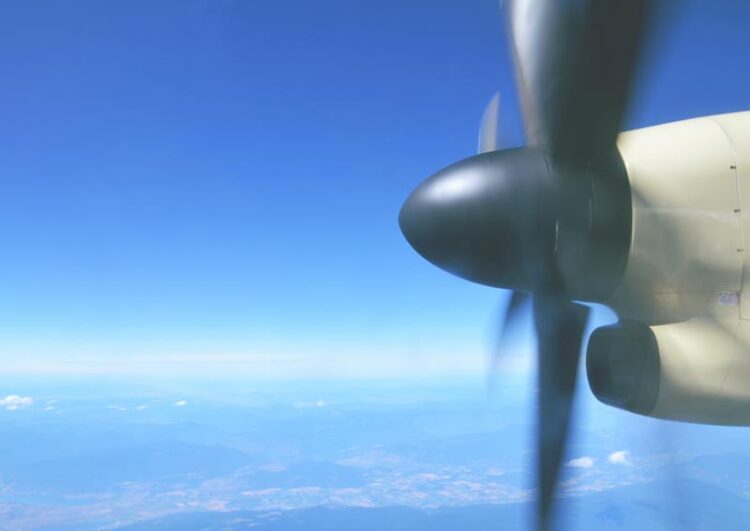Propeller advance paves way for quiet, efficient electric aviation

Researchers at Chalmers University of Technology, Sweden, have developed a propeller design optimisation method that paves the way for quiet and efficient electric aviation.
Credit: Christina Sicoli on Unsplash (CC BY-SA)
Electrification is seen as having an important role to play in the fossil-free aviation of tomorrow. But electric aviation is battling a trade-off dilemma: the more energy-efficient an electric aircraft is, the noisier it gets. Now, researchers at Chalmers University of Technology, Sweden, have developed a propeller design optimisation method that paves the way for quiet, efficient electric aviation.
In recent years, electrification has been described as having an important role in reducing emissions from future aviation. Due to the challenges posed by longer ranges, interest is chiefly focused on electric propeller planes covering shorter distances. Propellers connected to electric motors are considered the most efficient propulsion system for regional and domestic flights.
But while airplanes are electric, propellers cause another kind of emission – noise. The noise from the propeller blades wouldn’t just disturb air passengers. Future electric aircraft will need to fly at relatively low altitudes, with noise disturbance reaching residential areas and animal life.
Battling a trade-off dilemma
This is where the research community faces a dilemma. The ambition of developing electric aircraft that are both quiet and energy-efficient is somewhat thwarted by a trade-off problem.
“We can see that the more blades a propeller has, the lower the noise emissions. But with fewer blades, propulsion becomes more efficient and the electric aircraft can fly for longer. In that sense, there is a trade-off between energy efficiency and noise. This is something of an obstacle for electric aircrafts that are both quiet and efficient,” explains Hua-Dong Yao, Associate Professor and researcher in fluid dynamics and marine technology at Chalmers University of Technology.
An optimised design for quiet and efficient propellers
But now, Hua-Dong Yao and his research colleagues may be one step closer to a solution. They have succeeded in isolating and exploring the noise that occurs at the tip of the propeller blades, or “tip vortices”, a known but less well-explored source of noise. In isolating this noise, the researchers were able to fully understand its role in relation to other noise sources generated by propeller blades. By adjusting a range of propeller parameters, such as pitch angle, chord length and number of blades, the team found a way to optimise the propeller design and even out the trade-off effect between efficiency and noise. The method, described in the study published in the journal Aerospace, can now be used in the design process of quieter propellers for future electric aircraft.
“Modern aircraft propellers usually have two to four blades, but we’ve found that by using six blades designed using our optimisation framework, you can develop a propeller that’s both relatively efficient and quiet. The propeller achieves a noise reduction of up to 5-8 dBA* with only a 3.5 per cent thrust penalty, compared to a propeller with three blades. That’s comparable to the noise reduction of someone going from speaking in a normal conversation voice to the sound you would perceive in a quiet room,” says Hua-Dong Yao.
* A-weighted decibel (dBA or dB(A)) is an expression of the relative loudness of sounds as perceived by the human ear. A-weighting gives more value to frequencies in the mid-range of human hearing and less value to frequencies at the edges as compared to a flat audio decibel measurement. A-weighting is the standard for determining hearing damage and noise pollution.
More about the scientific publication
- The study Blade-Tip Vortex Noise Mitigation Traded-Off against Aerodynamic Design for Propellers of Future Electric Aircraft was published in the journal Aerospace.
- The authors are Hua-Dong Yao, Zhongjie Huang, Lars Davidson, Jiqiang Niu and Zheng-Wei Chen.
- The researchers are active at Chalmers University of Technology, Volvo Cars, School of Mechanical Engineering, Southwest Jiaotong University and The Hong Kong Polytechnic University, China.
- The research project has been funded by the Transport Area of Advance at Chalmers University of Technology.
- Link to the study: https://doi.org/10.3390/aerospace9120825
For more information, please contact:
Hua-Dong Yao, Associate Professor and researcher in fluid dynamics and marine technology, Department of Mechanics and Maritime Sciences, Chalmers University of Technology, Sweden
huadong.yao@chalmers.se, +46 31 772 14 05
Journal: Aerospace
DOI: 10.3390/aerospace9120825
Method of Research: Computational simulation/modeling
Subject of Research: Not applicable
Article Title: Blade-Tip Vortex Noise Mitigation Traded-Off against Aerodynamic Design for Propellers of Future Electric Aircraft
Article Publication Date: 15-Dec-2022
COI Statement: The authors declare no conflict of interest. The funders had no role in the design of the study; in the collection, analyses or interpretation of data; in the writing of the manuscript; or in the decision to publish the results.
All latest news from the category: Machine Engineering
Machine engineering is one of Germany’s key industries. The importance of this segment has led to the creation of new university degree programs in fields such as production and logistics, process engineering, vehicle/automotive engineering, production engineering and aerospace engineering among others.
innovations-report offers informative reports and articles covering technologies such as automation, motion, power train, energy, conveyor, plastics, lightweight construction, logistics/warehousing, measurement systems, machine tools and control engineering.
Newest articles

NTU and NUS spin-off cutting-edge quantum control technology
AQSolotl’s quantum controller is designed to be adaptable, scalable and cost-efficient. Quantum technology jointly developed at Nanyang Technological University, Singapore (NTU Singapore) and National University of Singapore (NUS) has now…

How Geothermal Energy Shapes Bavaria’s Green Future Through Sustainable Energy
The Bavarian State Ministry of Science and the Arts has extended its funding for the research association “Geothermal Alliance Bavaria,” with the University of Bayreuth (UBT) continuing as a member…

Spintronics memory innovation: A new perpendicular magnetized film
Long gone are the days where all our data could fit on a two-megabyte floppy disk. In today’s information-based society, the increasing volume of information being handled demands that we…



